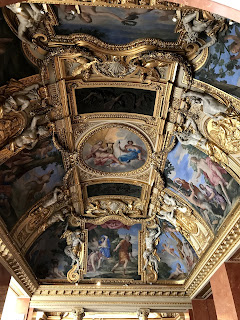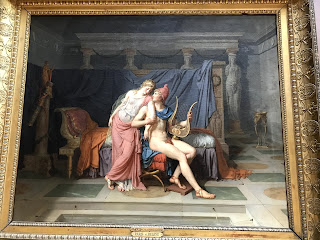Trip to Paris - Musée du Louvre
Musée du L’ouvre or thé Louvre Museum is the world’s largest art museum. The Louvre was originally built as a fortress in 1190, but later reconstructed to be a Royal Palace. During its time as a Royal Residence, every monarch expanded it. Today, it covers a total area of 652,300 square feet (60,600 square meters)
In total, there are 35000 works to be discovered including the masterpieces - the Mona Lisa, The Raft of the Medusa, the Venus de Milo and the Winged Victory Of Samothrace.
Mona Lisa - a MASTERPIECE by Leonardo da Vinci is the “the best known, the most visited, the most written about, the most sung about, work of art in the world”.
It is truly priceless as according to French heritage law - this painting cannot be bought or sold.
Two priceless smiles - Of course the second one is Mona Lisa
Psyche Revived by Cupid’s Kiss - it is regarded as a MASTERPIECE of Neoclassical sculpture that represents Cupid in the height of Love and tenderness, immediately after awakening the lifeless Psyche with a Kiss.
PS: Cupid is the god of Desire, Love, attraction and affection.
Roger délivrant Angélique, painting by Jean Auguste Dominique Ingres, inspired by Orlando Furioso by Ariosto.
Orlando Furioso, the tale of Roger, a knight, dressed in his Gold armour and whose steed is a hippogriff. A beautiful woman Angélique chained to a rock as a human sacrifice to a sea monster. As Roger rides to her aid, a great thrashing in the water occurs- it is the monster approaching Angélique. Roger drives his lance between the monster’s eyes and rescues Angélique.
Michael or Saint Michael is an archangel in Judaism, Christianity and Islam. He is also known as “The Archangel Michael”.
This is a painting by the Italian High Renaissance artist Raphael. Together with Michelangelo and Leonardo da Vinci, he forms the traditional trinity of great masters of that period.
St. John the Baptist is revered as a major religious figure in - Christianity, Islam, the Baha’i Faith and Mandaeism. He is called a “Prophet” by all of these traditions and is honoured as Saint.
This painting is believed to be Leonardo da Vinci’s final painting
The Wedding Feast at Cana, by the Italian artist Paolo Veronese, represents first public miracle of Jesus, where he converts water into wine.
Veronese’s depiction of the crowded banquet-scene that is The Wedding Feast at Cana is meant to be viewed upwards. On the horizontal axis - the lower half of the painting contains 130 human figures.
At the bottom left quarter - an elegant woman discreetly cleaning her teeth with a toothpick, and a woman urging her husband to ask the bride about the New Red Wine they have been served.
The pictorial area of the canvas makes The Wedding Feast at Cana the most expansive picture in the paintings collection of the Musée du Louvre.
Pygmalion and Galatée, is a painting by Anne-Louis Girodet.
The expression of the sculptor’s face is striking, where adoration mingles with surprise and fascination. In his posture, one feels his doubts, his expectation: with his left hand he dare not to touch Galatea, dare not believe in the miracle, even if his face illuminated by the grace of the statue, shows all his love and his devotion.
The painting gives the sensation of an uninterrupted movement and a movement frozen in time.
The Coronation Of Napoleon
The Intervention of the Sabine Women is a painting by Jacques-Louis David, showing a legendary episode following the abduction of the Sabine women by the founding generation of Rome.
The painting is a masterful summary of the whole episode. Hersilia is leaping between her father Tatius, the king of the Sabines, on the left, and her husband Romulus, the king of Rome, on the right. A woman is pointing at her children; another has thrown herself at a warrior's feet. The picture also evokes the happy consequences of their intervention. The horseman on the right is putting his sword back into its sheath while, further away, hands and helmets are raised in gestures of peace.
Paris and Helen - legendary Love Story.
The Winged Victory Of Samothrace, also called the Nike (Greek Goddess Of Victory) Of Samothrace was created around 2nd Century BC. It is one of the most celebrated Sculptures in the world.
The masterly rendering of the wavy drapes of her pleated “chiton” leaves the impression that the Goddess descends from the heavens and just alights the prow Of a ship with her right foot while her left is still in the air.
La Grande Odalisque
The Great Sphinx of Tanis is a granite sculpture of a sphinx, dated to the 26th century BC.
This impressive stone sculpture with its precise details and polished surfaces is a work of admirable craftsmanship. The recumbent lion, with tense body and outstretched claws, gives the impression of being ready to leap. The shen hieroglyph sculpted on the plinth under each paw evokes a cartouche, confirming the royal nature of the monument.
PS: When it was put into the Louvre, there was no machinery strong enough to lift, 4600 years old and 26 ton Sphinx, and carry it around. So, they made a hole in the wall and then the sphinx was pushed and pulled until it was in place. The hole was then sealed up again.
The Arc de Triomphe du Carrousel is often thought to be the same as the Arc de Triomphe de I’Etoile (commonly known as Arc de Triomphe). However, these are two different monuments.
Arc de Triomphe du Carrousel was built to commemorate Napoleon’s military victories of the previous year. It has entries on each of the four faces.
The famous Marble Arch in London was designed on the basis of the Arc de Triomphe du Carrousel.
All n all, we spend 1 whole day and manages to cover only 15-20%. However, i do wish to visit Musee du Louvre again. It's beautiful and it's rich.
Comment below and let me know your thoughts.
In total, there are 35000 works to be discovered including the masterpieces - the Mona Lisa, The Raft of the Medusa, the Venus de Milo and the Winged Victory Of Samothrace.
Mona Lisa - a MASTERPIECE by Leonardo da Vinci is the “the best known, the most visited, the most written about, the most sung about, work of art in the world”.
It is truly priceless as according to French heritage law - this painting cannot be bought or sold.
Two priceless smiles - Of course the second one is Mona Lisa
Psyche Revived by Cupid’s Kiss - it is regarded as a MASTERPIECE of Neoclassical sculpture that represents Cupid in the height of Love and tenderness, immediately after awakening the lifeless Psyche with a Kiss.
PS: Cupid is the god of Desire, Love, attraction and affection.
Roger délivrant Angélique, painting by Jean Auguste Dominique Ingres, inspired by Orlando Furioso by Ariosto.
Orlando Furioso, the tale of Roger, a knight, dressed in his Gold armour and whose steed is a hippogriff. A beautiful woman Angélique chained to a rock as a human sacrifice to a sea monster. As Roger rides to her aid, a great thrashing in the water occurs- it is the monster approaching Angélique. Roger drives his lance between the monster’s eyes and rescues Angélique.
Michael or Saint Michael is an archangel in Judaism, Christianity and Islam. He is also known as “The Archangel Michael”.
This is a painting by the Italian High Renaissance artist Raphael. Together with Michelangelo and Leonardo da Vinci, he forms the traditional trinity of great masters of that period.
St. John the Baptist is revered as a major religious figure in - Christianity, Islam, the Baha’i Faith and Mandaeism. He is called a “Prophet” by all of these traditions and is honoured as Saint.
This painting is believed to be Leonardo da Vinci’s final painting
The Wedding Feast at Cana, by the Italian artist Paolo Veronese, represents first public miracle of Jesus, where he converts water into wine.
Veronese’s depiction of the crowded banquet-scene that is The Wedding Feast at Cana is meant to be viewed upwards. On the horizontal axis - the lower half of the painting contains 130 human figures.
At the bottom left quarter - an elegant woman discreetly cleaning her teeth with a toothpick, and a woman urging her husband to ask the bride about the New Red Wine they have been served.
The pictorial area of the canvas makes The Wedding Feast at Cana the most expansive picture in the paintings collection of the Musée du Louvre.
The expression of the sculptor’s face is striking, where adoration mingles with surprise and fascination. In his posture, one feels his doubts, his expectation: with his left hand he dare not to touch Galatea, dare not believe in the miracle, even if his face illuminated by the grace of the statue, shows all his love and his devotion.
The painting gives the sensation of an uninterrupted movement and a movement frozen in time.
The Coronation Of Napoleon
The Intervention of the Sabine Women is a painting by Jacques-Louis David, showing a legendary episode following the abduction of the Sabine women by the founding generation of Rome.
The painting is a masterful summary of the whole episode. Hersilia is leaping between her father Tatius, the king of the Sabines, on the left, and her husband Romulus, the king of Rome, on the right. A woman is pointing at her children; another has thrown herself at a warrior's feet. The picture also evokes the happy consequences of their intervention. The horseman on the right is putting his sword back into its sheath while, further away, hands and helmets are raised in gestures of peace.
Paris and Helen - legendary Love Story.
The Winged Victory Of Samothrace, also called the Nike (Greek Goddess Of Victory) Of Samothrace was created around 2nd Century BC. It is one of the most celebrated Sculptures in the world.
The masterly rendering of the wavy drapes of her pleated “chiton” leaves the impression that the Goddess descends from the heavens and just alights the prow Of a ship with her right foot while her left is still in the air.
La Grande Odalisque
This impressive stone sculpture with its precise details and polished surfaces is a work of admirable craftsmanship. The recumbent lion, with tense body and outstretched claws, gives the impression of being ready to leap. The shen hieroglyph sculpted on the plinth under each paw evokes a cartouche, confirming the royal nature of the monument.
PS: When it was put into the Louvre, there was no machinery strong enough to lift, 4600 years old and 26 ton Sphinx, and carry it around. So, they made a hole in the wall and then the sphinx was pushed and pulled until it was in place. The hole was then sealed up again.
The Arc de Triomphe du Carrousel is often thought to be the same as the Arc de Triomphe de I’Etoile (commonly known as Arc de Triomphe). However, these are two different monuments.
Arc de Triomphe du Carrousel was built to commemorate Napoleon’s military victories of the previous year. It has entries on each of the four faces.
The famous Marble Arch in London was designed on the basis of the Arc de Triomphe du Carrousel.
All n all, we spend 1 whole day and manages to cover only 15-20%. However, i do wish to visit Musee du Louvre again. It's beautiful and it's rich.




























Comments